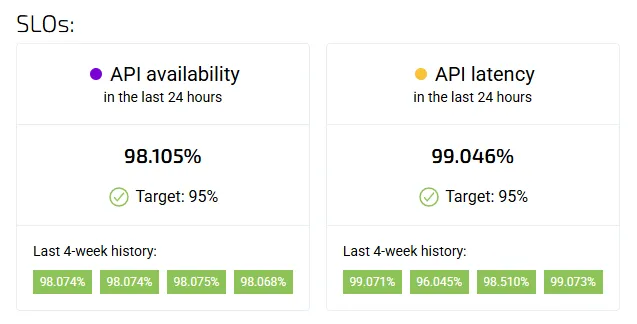Set up a Blameless Post-Mortem process in 7 steps

Published on 20 April 2023 by Arjan Franzen

A post-mortem is a retrospective analysis of an incident or outage that occurred in a software system. A post-mortem aims to identify the root cause of the issue, evaluate the response to the incident, and develop a plan for preventing similar incidents from occurring in the future through improvements of the software system or processes.
Post-mortems should be held as soon as possible after the incident has been resolved while the details of the event are still fresh in the minds of the team members involved. The analysis should involve a diverse set of stakeholders, including developers, operations personnel, and business leaders.
Why Post-Mortems?
Post-mortems are critical to improving the reliability of software systems for several reasons:
- Post-Mortems help to identify the root cause of an issue: By analysing the incident, the team can identify the root cause of the problem, which may be due to a bug in the code, a misconfiguration of the system, or a failure of a third-party service. Once the root cause has been identified, the team can develop a plan to address it.
- Post-Mortems enable continuous improvement: By analysing incidents and developing plans to prevent similar incidents, the team can continuously improve the reliability of the system. This helps to ensure that the system is more resilient to future failures and that downtime is minimised.
- Post-Mortems promote collaboration: Post-mortems require input from multiple stakeholders, including developers, operations personnel, and business leaders. This encourages collaboration and communication across teams, leading to a better understanding of the system and its dependencies.
- Post-Mortems foster a culture of accountability: By conducting post-mortems, the team takes ownership of the issue and commits to improving the system. This fosters a culture of accountability and encourages team members to take responsibility for the reliability of the system.
How to implement a Post-Mortem process?
To implement the SRE concept of a Blameless Post-Mortem, you can follow the following steps:
- Establish a culture of blamelessness: It is essential to create a blame-free environment where team members can openly discuss problems without fear of being punished. Encourage team members to take ownership of their mistakes and share their experiences so that everyone can learn from them.
- Define the scope and objective of the post-mortem: Decide what you want to achieve from the post-mortem. Define the scope of the investigation, such as the timeline of the incident, the systems and processes involved, and the impact of the incident on the business.
- Collect data and evidence: Collect all the relevant data and evidence, such as logs, metrics, and incident reports. Use these to create a timeline of the incident and identify the root cause.
- Analyse the data and identify the root cause: Conduct a detailed analysis to identify the incident's root cause. This should involve identifying the contributing factors, such as misconfigured systems, inadequate monitoring, or human error.
- Develop a remediation plan: Based on the analysis, develop a remediation plan that addresses the incident's root cause. This plan should be focused on preventing similar incidents from happening in the future.
- Communicate the findings and remediation plan: Share the findings of the investigation and the remediation plan with all relevant stakeholders. This should include both technical and non-technical team members.
- Follow up on the remediation plan: Monitor the implementation of the remediation plan and track progress over time. This will help you identify any new issues and ensure that the plan is effective.
Before you start
Before starting with the post-mortems, it is crucial to ensure that the following conditions are met:
- Leadership buy-in: Top-level management should be supportive of the post-mortem process and encourage teams to participate.
- Team buy-in: Team members should understand the benefits of the post-mortem process and be willing to participate.
- Resources: Adequate resources should be allocated to support the post-mortem process, such as tools, engineer who are trained to use the tools and reserve time for trying out Post Mortems.
What about the developers?
To persuade Operations teams to start doing post-mortems after every production outage, you can highlight the following benefits:
- Learning from mistakes: Post-mortems help teams identify and learn from their mistakes, improving their processes and systems.
- Preventing future incidents: By identifying and addressing the root cause of an incident, teams can prevent similar incidents from happening in the future.
- Team building: Post-mortems encourage collaboration and communication between different teams, improving team cohesion and effectiveness.

To persuade developers to join these post-mortems, you can emphasise that:
- Developers play a crucial role in ensuring the stability and reliability of the system.
- Post-mortems provide an opportunity for developers to learn from incidents and improve their code.
- Developers can contribute to the remediation plan by suggesting improvements to the code or architecture.
Conclusion
Post-mortems are a critical tool for improving the reliability of software systems. By analyzing incidents, identifying the root cause of issues, and developing plans to prevent similar incidents in the future, teams can continuously improve the system's reliability and resilience. By establishing a blame-free culture, defining the scope and objective of the post-mortem, and communicating the benefits of the process to all stakeholders, you can successfully implement the Site Reliability Engineering (SRE) concept of a Blameless Post-Mortem.
Supercharge your Software Delivery!
Implement DevOps with Agile Analytics
Implement Site Reliability with Agile Analytics
Implement Service Level Objectives with Agile Analytics
Implement DORA Metrics with Agile Analytics





